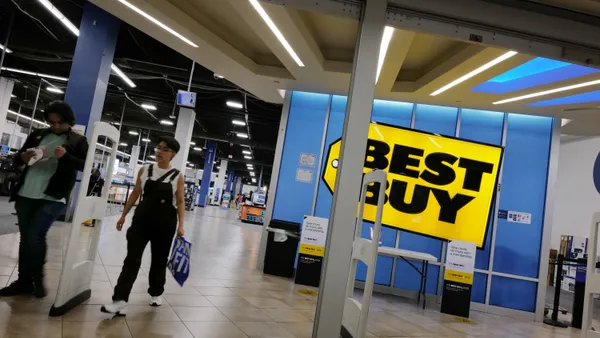Dive Brief:
-
After spending some $2.7 billion on higher starting wages Wal-Mart is seeing big boosts in customer satisfaction ratings in its stores, based on internal measurements of checkout speed, store cleanliness, in-stock items, and helpfulness of workers, Fortune reports.
-
The retailer said that customer service scores for "clean, fast, and friendly" stores have risen for a consecutive 79 weeks.
-
In further news, Wal-Mart is also testing drones at warehouses to improve fulfillment efficiencies, the Associated Press reports.
Dive Insight:
Wal-Mart is apparently learning what other retailers have known for a long time: paying employees well translates to superior customer service.
The push to better pay and train store associates likely also helped boost Wal-Mart's customer experience measured by Cowen and Co. late last year. Cowen found that 75% of 2,506 Wal-Mart customers surveyed said they are satisfied with their overall shopping experience, and 60% were satisfied with the customer service. Both measurements were the best in about two years, though they still lag behind Wal-Mart rival Target.
“It’s the tiny, noticeable things that should be in our DNA,” Walmart U.S. COO Judith McKenna said at a meeting with employees this week ahead of the retailer’s annual meeting Friday, according to Fortune. “Giving away a smile costs nothing.”
A smile, though, comes a bit easier if store staff are earning above minimum wage; for Wal-Mart, that is indeed costing something, counted in billions of dollars. But it's also helping the retailer compete during a tough time for retailers, which are seeing slowing store traffic as customers go online. Retailers, now more than ever, are realizing that they need more incentives to draw customers to their stores.
To capture customers already online, Wal-Mart is under pressure to improve its e-commerce—and it looks like testing drones is just one answer to boost warehouse efficiencies and fulfillment times.
“Wal-Mart's e-commerce business is among the more complex in the world, and it's still a tiny fraction of their vastly complex brick-and-mortar business,” Keith Anderson, VP of strategy and insight at e-commerce analytics firm Profitero, told Retail Dive in an email earlier this year.
Wal-Mart reported a minimal 8% growth in online sales in the fourth quarter, which included the holiday season. It’s not quite copacetic to compare Wal-Mart—the largest retailer not just in the U.S. but in the world—to rivals Amazon or Target, which pale in comparison by several measures, but Amazon saw a 22% growth during the same quarter, while Target boosted its online sales by 34%, helped by its holiday-time free shipping policy.
Even with these numbers, Nick Egelanian, president of retail development consultants SiteWorks International, told Retail Dive that it would be a mistake for Wal-Mart to move too far from its brick-and-mortar stronghold for the sake of e-commerce growth.
“Wal-Mart is the biggest retailer in the world, and their system is selling through brick-and-mortar,” Egelanian said. “And they’re efficient. We know that Wal-Mart has the most efficient system in the world. We know that they break that product down and put it on the shelves, and they do that very efficiently also, and then they’re done. And selling on the Internet is not efficient. The whole methodology of selling on the internet is completely foreign to what it’s like selling at a Wal-Mart.”














